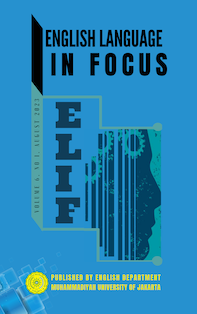Strengthening Non-English Teachers’ Ability in Using English as Instructional Language
DOI:
https://doi.org/10.24853/elif.6.2.185-190Keywords:
communicative approach, teaching method, speaking abilityAbstract
This study aimed to prove the effectiveness of communicative approach to strengthen non-English teachers’ speaking ability in using English as their instructional language. The study was carried out at SD Lab-school FIP UMJ, South Tangerang in the even semester of 2023/2024 academic year. There were 30 teachers of all grades participated in this study. This research was mixed-methods with statistics descriptive approach. Both speaking pre-post tests and observation were used in collecting the data. The results of the tests were analyzed by using simple calculation and reported in the form of average score. Meanwhile, the results of the observation were described descriptively. The findings of the quantitative approach revealed that on the average the learners performed better in the post-test and their average score escalated up to 22.17 points from the pre-test. Whereas the results of the observation as part of qualitative approach showed that the learners were able to manage their speaking problems better in which they became more confident, had more vocabularies and were able to construct proper sentences. To conclude, this research work confirmed that communicative approach was effective to strengthen non-English teachers’ speaking ability.References
Amalia, R.D. & Anggraeni, A. (2021). The students do not want to speak English. PROJECT: Professional Journal of English Education, 4(1), 75-79. DOI: https://doi.org/10.22460/project.v4i1.p75-79.
Ananda, N. & Hastini, H. (2023). A study on self-confidence impact of EFL students’ speaking. Journal on General Education and Humanities, 2(3), 237-246. DOI: https://doi.org/10.58421/gebu.v2i3.158.
Dolati, R.I., & Mousavi, S.N., (2014). Non-native speaking learners (N.N.S.L) strategies (metacognitive, cognitive and affective strategies). International Journal of English Language Teaching, 2(2), 37-60.
Gutierrez-Heras, C.B. & Camino, M.A.V. (2022). Communicative language teaching to enhance speaking skills in B1.1 level. Pol. Con. (Edición núm. 69), 7(4), 1304-1318.
Jabeen, S.S. (2014). Implementation of communicative approach. English Language Teaching, 7(8), 68-74.
Mampuono, M. (2022). Pentingnya bahasa Inggris di era 4.0 untuk mendukung peningkatan mutu pendidikan. Balai Besar Penjaminan Mutu (BBPMP) Provinsi Jawa Tengah, accessed from: https://bbmpjatenga.kemdikbud.go.id.
Misliyadi, M. (2023). Using a communicative approach to teaching speaking skills at Ibrahimy university. Jurnal Multidisiplin Ibrahimy, 1(1), 36-52. DOI: https://doi.org/10.35316/jummy.v1i1.3536.
Muñoz, CGC. (2024). Descriptive vs inferential statistics: An overview, accessed from: https://s4be.cochrane.org.
Samad, P., & Kafryawan, W. (2021). Strategies in learning speaking skills used by the adult TEFL students. KARIWARI SMART: Rumah Jurnal IAIN Fattahul Muluk, 1(2) 49-57. DOI: https://doi.org/10.53491/kariwarasmart.v1i2.46.
Soreh, R., Pelenkahu, N., & Muntuuntu, M. (2022). Problems encountered by the students in speaking English at twelfth grade of SMAN 2 Gemeh. JoTELL: Journal of Teaching English, Linguistics, and Literature, 1(5), 576-587.
Suesmith, M.E. (2011). The communicative language approach: Theory and practice. Magister Science, 30, 1-9.
Qasserras, L. (2023). Systematic review of communicative language teaching (CLT) in language education: A balanced perspective. EJ-EDU: European Journal of Education and Pedagogy, 4(6), 17-23. DOI: https://doi.org/10.24018/ejedu.2023.4.5.763.
Downloads
Published
Issue
Section
License
Authors who publish with this journal agree to the following terms:
- Authors retain copyright and grant the journal right of first publication with the work simultaneously licensed under a Creative Commons Attribution License that allows others to share the work with an acknowledgment of the work's authorship and initial publication in this journal.
- Authors can enter into separate, additional contractual arrangements for the non-exclusive distribution of the journal's published version of the work (e.g., post it to an institutional repository or publish it in a book), with an acknowledgment of its initial publication in this journal.
- Authors are permitted and encouraged to post their work online (e.g., in institutional repositories or on their website) before and during the submission process, as it can lead to productive exchanges, as well as earlier and greater citation of published work (See The Effect of Open Access).


